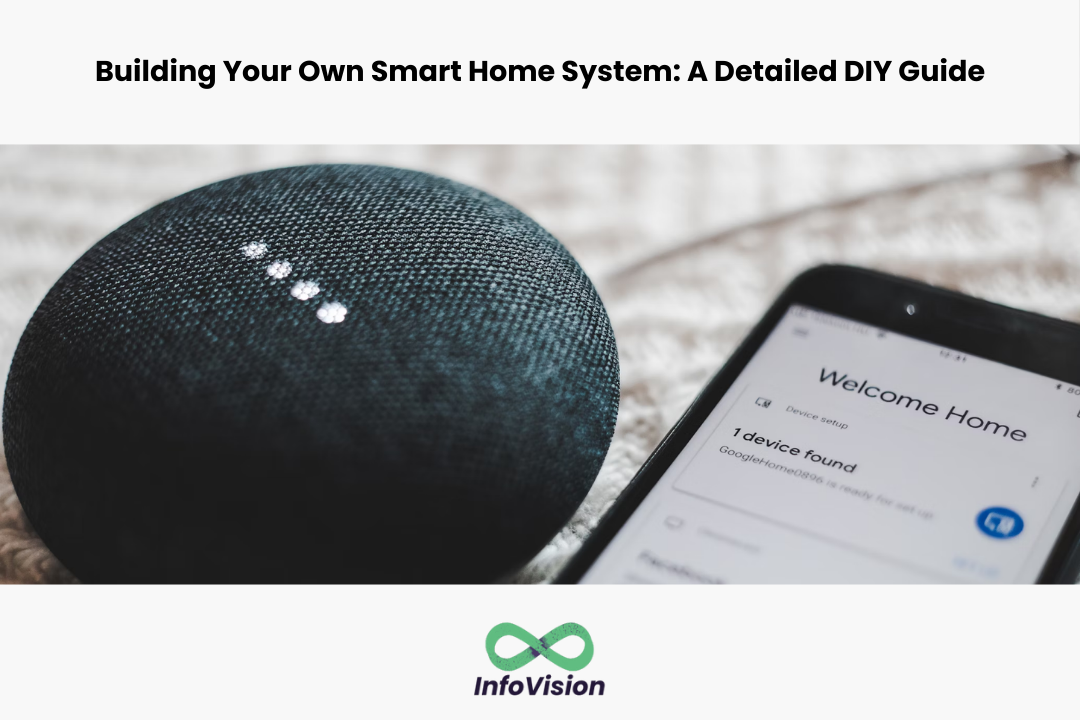Building Your Own Smart Home System: A Detailed DIY Guide
Building a smart home system is no longer a luxury reserved for the wealthy. With the increasing popularity of smart home devices, it has become easier and more affordable to build a smart home system. A smart home system allows you to control and automate various aspects of your home, such as lighting, temperature, security, and entertainment, from a single device.
Building a smart home system from scratch may seem daunting, but with the right knowledge and tools, it can be a fun and rewarding project. This detailed DIY guide will provide step-by-step instructions on how to build your own smart home system. It will cover everything from selecting the right smart home devices, setting up a smart home hub, and integrating all the devices into a cohesive system. By the end of this guide, readers will have the knowledge and confidence to build their own smart home system tailored to their needs and preferences.
Understanding Smart Home Basics
What Is a Smart Home?
A smart home is a house that uses modern technology to automate and control various systems and appliances. Smart home systems can be used to control lighting, temperature, security, entertainment, and more. Smart homes are becoming increasingly popular as more people realize the benefits they offer.
Benefits of a Smart Home
There are several benefits of having a smart home. For example, a smart home can help you save money on energy bills by automating your heating and cooling systems. Smart homes can also improve security by allowing you to monitor your home remotely and receive alerts if there is any suspicious activity.
In addition, smart homes can make your life more convenient by automating tasks such as turning on lights and opening blinds. They can also help you stay connected to your home and loved ones by allowing you to control your home systems remotely and receive alerts if there is any unusual activity.
Overall, a smart home can help you save time, money, and energy while improving your quality of life. By understanding the basics of smart home technology, you can start building your own smart home system and enjoy the benefits it offers.
Planning Your Smart Home System
Building a smart home system can be an exciting and rewarding experience. However, it requires careful planning to ensure that the end result meets your needs and budget. In this section, we will discuss the key factors to consider when planning your smart home system.
Setting Goals and Budget
Before embarking on a smart home project, it is important to set clear goals and establish a budget. Goals may include increased security, energy efficiency, or convenience. Once goals are established, a budget should be set to ensure that the project remains financially feasible.
Choosing the Right Ecosystem
Choosing the right ecosystem is crucial when building a smart home system. An ecosystem is a collection of devices and software that work together to create a seamless experience. It is important to choose an ecosystem that is compatible with the devices you already own or plan to purchase. Some popular ecosystems include Amazon Alexa, Google Assistant, and Apple HomeKit.
Creating a Scalable Plan
A scalable plan is essential when building a smart home system. The plan should be designed to accommodate future growth and changes. It is important to consider factors such as the number of rooms in the house, the number of devices to be installed, and the level of automation required. A scalable plan will ensure that the smart home system remains functional and relevant for years to come.
In conclusion, careful planning is key to building a successful smart home system. Setting clear goals, establishing a budget, choosing the right ecosystem, and creating a scalable plan are all important factors to consider. By following these guidelines, anyone can create a smart home system that meets their needs and budget.
Selecting Core Components
Building your own smart home system requires selecting the right components that suit your needs. The core components include smart hubs and controllers, connectivity protocols, and sensors and actuators.
Smart Hubs and Controllers
A smart hub or controller is the central brain of your smart home system. It connects all your smart devices and allows you to control them from a single app or device. Some popular smart hubs include Amazon Echo, Google Home, and Samsung SmartThings.
When selecting a smart hub, consider its compatibility with your existing devices, the range of protocols it supports, and the ease of use. Some hubs support only a few protocols, while others support a wide range of protocols such as Wi-Fi, Bluetooth, Zigbee, and Z-wave.
Connectivity Protocols
Connectivity protocols are the communication channels that connect your smart devices to the smart hub or controller. Some popular protocols include Wi-Fi, Bluetooth, Zigbee, and Z-wave.
When selecting a connectivity protocol, consider its range, power consumption, and compatibility with your smart hub or controller. For example, Wi-Fi has a longer range but consumes more power than Zigbee, which has a shorter range but consumes less power.
Sensors and Actuators
Sensors and actuators are the devices that detect changes in the environment and trigger actions in response. Some popular sensors include motion sensors, temperature sensors, and light sensors. Some popular actuators include smart switches, smart plugs, and smart locks.
When selecting sensors and actuators, consider their compatibility with your smart hub or controller, their range, and their power consumption. For example, a motion sensor that runs on batteries may have a longer battery life than one that runs on AC power.
By selecting the right core components, you can build a smart home system that meets your needs and enhances your lifestyle.
Designing the Network Infrastructure
When building a smart home system, one of the most important considerations is the network infrastructure. This includes both wired and wireless connections, as well as network security considerations.
Wired vs Wireless
When it comes to connecting devices in a smart home system, there are two main options: wired and wireless. Wired connections typically provide faster and more reliable connectivity, but can be more difficult to install and may require professional assistance. Wireless connections, on the other hand, are easier to install and more flexible, but may be less reliable and slower than wired connections.
When deciding between wired and wireless connections, it’s important to consider the specific needs of the smart home system. For example, devices that require high-speed connectivity, such as security cameras and streaming media devices, may benefit from a wired connection. Devices that are more mobile, such as smartphones and tablets, may be better suited for a wireless connection.
Network Security Considerations
Another important consideration when designing the network infrastructure for a smart home system is network security. With so many devices connected to the network, it’s important to ensure that the network is secure and protected from potential threats.
Some key network security considerations include:
- Firewalls: A firewall can help to protect the network from unauthorized access and potential threats.
- Encryption: Encryption can help to protect data transmitted over the network, making it more difficult for hackers to intercept and access sensitive information.
- Password Management: It’s important to use strong passwords and to change them regularly to help prevent unauthorized access to the network.
- Software Updates: Keeping software up to date can help to protect the network from known vulnerabilities and potential threats.
By taking these network security considerations into account, it’s possible to design a smart home system that is both functional and secure.
Implementing Control Interfaces
After setting up the smart devices and connecting them to the network, the next step is to implement control interfaces. Control interfaces are the means through which the user interacts with the smart home system. There are several types of control interfaces that can be used to control smart home devices, including mobile and web apps, voice assistants, and physical control panels.
Mobile and Web Apps
Mobile and web apps are the most common control interfaces for smart home systems. These apps allow users to control their smart devices from anywhere using their smartphones or computers. Most smart home devices come with their own mobile app, which can be downloaded from the app store. Some popular smart home apps include Amazon Alexa, Google Home, and Apple HomeKit.
These apps allow users to control their smart devices with just a few taps on their smartphone screen. Users can turn on/off lights, adjust thermostat settings, lock/unlock doors, and perform other actions using the app. Some apps even allow users to create custom scenes, which can be activated with a single tap.
Voice Assistants
Voice assistants are another popular control interface for smart home systems. Voice assistants such as Amazon Alexa, Google Assistant, and Apple Siri allow users to control their smart devices using voice commands. Users can simply say “Alexa, turn off the lights” or “Hey Google, lock the front door” to control their smart devices.
Voice assistants can be integrated with smart home devices using the mobile app or web interface. Once integrated, users can control their smart devices using voice commands from anywhere in the room. Voice assistants can also be used to create custom routines, which can be activated with a single voice command.
Physical Control Panels
Physical control panels are another option for controlling smart home devices. These panels can be installed on the wall and used to control multiple smart devices at once. Physical control panels are ideal for users who prefer a more traditional control interface or who do not want to use their smartphone or voice commands.
Physical control panels can be programmed to control multiple smart devices at once. For example, users can create a “Good Night” routine that turns off all the lights, locks the doors, and adjusts the thermostat to a comfortable temperature. Physical control panels can also be customized with different colors and designs to match the user’s home decor.
In conclusion, implementing control interfaces is an essential step in building a smart home system. Mobile and web apps, voice assistants, and physical control panels are all viable options for controlling smart devices. Users can choose the control interface that best suits their needs and preferences.
Automating with Smart Devices
Smart devices make it easy to automate your home. You can control your lights, thermostat, locks, and security cameras with just a few taps on your smartphone. Here are some of the most popular smart devices to consider when building your own smart home system.
Smart Lighting
Smart lighting is an essential component of any smart home system. With smart bulbs, you can control the brightness and color of your lights, set schedules, and even create scenes that match your mood. For example, you can set your lights to turn on gradually in the morning to simulate a sunrise, or turn them off automatically when you leave the house.
Smart Thermostats
Smart thermostats allow you to control your home’s temperature from anywhere, using your smartphone or voice commands. They can also learn your preferences over time and automatically adjust the temperature to your liking. Some models even use geofencing to detect when you’re leaving or arriving home and adjust the temperature accordingly.
Smart Locks and Security Cameras
Smart locks and security cameras can help you keep your home safe and secure. With a smart lock, you can lock and unlock your doors remotely, or even give temporary access to guests or service providers. Security cameras can provide real-time video feeds of your home, and some models even have built-in motion detectors and sirens to deter intruders.
In summary, automating your home with smart devices can make your life easier and more convenient. Smart lighting, thermostats, locks, and security cameras are just a few of the many smart devices available to help you build your own custom smart home system.
Integrating Entertainment Systems
Building a smart home system is not just about automating your lights and thermostat. It also involves integrating your entertainment systems. With a smart entertainment system, you can easily control your TV, speakers, and other audio components with a single device.
Smart TVs and Speakers
Smart TVs and speakers are becoming increasingly popular in modern homes. They allow you to access a wide range of content, from streaming services to online videos and music. You can also control them using voice commands or a smartphone app.
To integrate your smart TV and speakers into your smart home system, you need to make sure they are compatible with your home automation platform. Most smart TVs and speakers are compatible with popular platforms like Amazon Alexa, Google Assistant, and Apple HomeKit.
Once your devices are connected to your smart home system, you can use voice commands or a smartphone app to control them. For example, you can say “Alexa, turn on the TV” or “Hey Google, play some music on the speakers.”
Multi-room Audio Systems
Multi-room audio systems allow you to play music in different rooms of your home at the same time. This is great for parties or when you want to listen to music while doing chores around the house.
To set up a multi-room audio system, you need to install speakers in each room and connect them to a central hub. The hub acts as a control center, allowing you to select which speakers to play music on.
There are many different multi-room audio systems available, each with its own set of features and capabilities. Some popular options include Sonos, Bose, and Yamaha.
Once your multi-room audio system is set up, you can control it using a smartphone app or a voice assistant. For example, you can say “Hey Siri, play some music in the living room” or “Alexa, play some jazz in the bedroom.”
Energy Management and Efficiency
Smart home systems can help homeowners manage their energy consumption and save money on their bills. There are two main ways to achieve this: using smart meters and monitors, and implementing energy-saving strategies.
Smart Meters and Monitors
Smart meters and monitors are devices that track energy usage in real-time. They can be installed on individual appliances or throughout the home to give an overall view of energy consumption. By monitoring energy usage, homeowners can identify areas where energy is being wasted and take steps to reduce consumption.
Smart meters can also help homeowners take advantage of time-of-use pricing, which charges different rates for energy depending on the time of day. By using appliances during off-peak hours, homeowners can save money on their energy bills.
Energy-Saving Strategies
In addition to using smart meters and monitors, there are many other strategies homeowners can use to save energy in their smart homes. These include:
- Using energy-efficient appliances and light bulbs
- Installing a programmable thermostat to regulate heating and cooling
- Using natural light instead of artificial light
- Turning off appliances and electronics when not in use
- Sealing windows and doors to prevent drafts
By implementing these strategies, homeowners can reduce their energy consumption and save money on their bills. Smart home systems can automate many of these strategies, making it easier for homeowners to save energy without sacrificing comfort or convenience.
Troubleshooting and Maintenance
Smart home systems are complex and can sometimes encounter issues that require troubleshooting. Here are some common issues that may arise and how to fix them.
Common Issues
- Device Connectivity Issues: Sometimes, devices may disconnect from the network and fail to reconnect. In such cases, it is recommended to restart the router and the device. If that doesn’t work, try resetting the device to its factory settings and reconnecting it to the network.
- Interference: Interference from other wireless devices can cause connectivity issues. Try moving the device closer to the router or switch to a different wireless channel to reduce interference.
- Software Issues: Software issues can cause devices to malfunction or not work as expected. In such cases, check for software updates and install them if available. If the issue persists, try resetting the device to its factory settings.
Software Updates
Software updates are important to keep devices working properly and secure. Most smart home systems have automatic software updates enabled by default, but it’s still a good idea to check for and install updates manually periodically.
To check for software updates, navigate to the device’s settings and look for a “Software Update” or “Firmware Update” option. If an update is available, follow the instructions to install it.
Technical Support
If all else fails, it may be necessary to contact technical support. Most smart home system manufacturers have dedicated technical support teams that can assist with troubleshooting and resolving issues.
Before contacting technical support, make sure to have the device’s model number and serial number handy. Also, be prepared to describe the issue in detail and provide any error messages that may have been displayed.
Enhancing with Advanced Features
Building a smart home system is an exciting project that can make your life more convenient and efficient. Once you have the basics down, it’s time to consider adding advanced features that can take your smart home to the next level. In this section, we’ll explore two popular advanced features: machine learning and AI, and geofencing and location-based controls.
Machine Learning and AI
Machine learning and AI are two technologies that can greatly enhance the capabilities of your smart home system. By using machine learning algorithms, your smart home can learn your habits and preferences, and adjust settings automatically to suit your needs. For example, if you always turn on the lights in your living room at 7 pm, your smart home can learn this and turn on the lights automatically at that time.
AI takes things a step further by allowing your smart home to make decisions based on data it collects from your home and your habits. For example, if your smart home detects that you’re not home and the temperature is dropping, it can turn on the heat automatically to keep your home comfortable.
Geofencing and Location-Based Controls
Geofencing and location-based controls are another set of advanced features that can greatly enhance your smart home system. Geofencing allows your smart home to detect when you’re leaving or arriving home based on your location. This can trigger a variety of actions, such as turning off the lights when you leave, or turning on the heat when you’re on your way home.
Location-based controls take things a step further by allowing you to control your smart home based on your location. For example, you can set your smart home to turn on the lights in your bedroom when you’re within a certain distance of your home. This can be especially useful if you have your hands full and can’t use your phone to control your smart home.
In conclusion, adding advanced features like machine learning and AI, and geofencing and location-based controls can greatly enhance the capabilities of your smart home system. By taking advantage of these features, you can make your life more convenient, efficient, and enjoyable.
Evaluating and Expanding Your System
Once you have successfully set up your smart home system, you should evaluate its performance metrics regularly. This will help you optimize the system for better functionality and efficiency.
Performance Metrics
To evaluate the performance of your smart home system, you can track the following metrics:
- Response time: This is the time taken by the system to respond to your commands. A good smart home system should respond instantly to your commands.
- Reliability: The system should be reliable and perform as expected. It should not have any downtime or connectivity issues.
- Energy consumption: Smart home devices should be energy efficient. You can track the energy consumption of your devices and optimize them for better energy efficiency.
- Security: Security is a crucial aspect of a smart home system. You should regularly check the security measures of your system and update them if necessary.
By tracking these metrics, you can ensure that your smart home system is performing optimally and efficiently.
Upgrading and Adding Devices
As your needs change, you may need to upgrade or add devices to your smart home system. When adding new devices, make sure they are compatible with your existing system.
You may also need to upgrade your system to support new features or technologies. Upgrading your system may involve replacing old devices or adding new ones.
Before upgrading or adding devices, make sure to research and compare different options. Look for devices that are reliable, energy efficient, and compatible with your existing system.
Overall, evaluating and expanding your smart home system is an ongoing process. Regularly tracking performance metrics and upgrading or adding devices as needed will help you optimize your system for better functionality and efficiency.
Frequently Asked Questions
What are the essential components needed to build a DIY smart home system?
To build a DIY smart home system, you will need some essential components such as a smart hub, smart devices, and a reliable internet connection. The smart hub acts as the central control unit that connects all the smart devices in your home. Some popular smart hubs include Amazon Echo, Google Home, and Apple HomeKit. Smart devices include smart bulbs, smart thermostats, smart locks, and smart security cameras. A reliable internet connection is necessary to ensure that all your smart devices can communicate with each other and with your smart hub seamlessly.
How can I integrate different smart devices to create a cohesive home automation system?
To integrate different smart devices to create a cohesive home automation system, you need to ensure that they are all compatible with your smart hub. Most smart hubs support a wide range of smart devices, but it is always best to check the compatibility before purchasing any new devices. Once you have confirmed compatibility, you can connect each device to your smart hub and customize the settings to create a cohesive home automation system.
What is the most cost-effective approach to converting my house into a smart home?
The most cost-effective approach to converting your house into a smart home is to start small and gradually add more smart devices over time. Begin by purchasing a smart hub and a few essential smart devices such as smart bulbs, a smart thermostat, and a smart security camera. As you become more comfortable with your smart home system, you can add more devices to enhance your home automation experience.
What are the security implications of creating a smart home and how can I address them?
Creating a smart home can increase the risk of cybersecurity threats such as hacking and data breaches. To address these security implications, it is essential to ensure that all your smart devices are secure and up to date with the latest software updates. You should also use strong and unique passwords for all your smart devices and enable two-factor authentication whenever possible. Additionally, consider using a virtual private network (VPN) to encrypt your internet traffic and protect your home network from cyber threats.
How can I create a smart home system that is compatible with multiple voice assistants?
To create a smart home system that is compatible with multiple voice assistants such as Amazon Alexa and Google Assistant, you need to ensure that your smart hub supports multiple voice assistants. Most smart hubs support multiple voice assistants, but it is always best to check the compatibility before purchasing any new devices. Once you have confirmed compatibility, you can connect your smart hub to each voice assistant and customize the settings to use your preferred voice assistant for each device.
What are the best practices for maintaining and updating a self-built smart home system?
To maintain and update a self-built smart home system, it is essential to keep all your smart devices up to date with the latest software updates. This ensures that your devices are secure and functioning correctly. It is also important to regularly check the compatibility of your devices with your smart hub and voice assistants to ensure that they are all working together seamlessly. Finally, consider creating a backup of your smart home system settings in case of any system failures or data loss.





